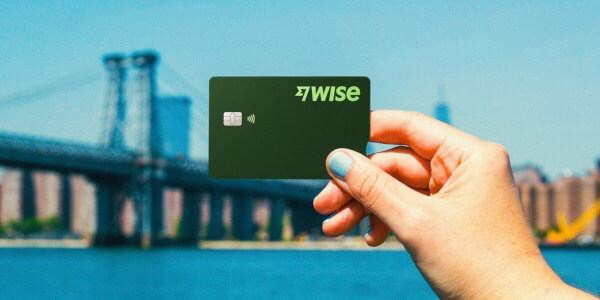Best joint business bank accounts in the UK
Looking for the best joint business accounts in the UK? We compare features, fees and best usage to help you find the ideal shared account.

Thinking of selling on Amazon? If you want to reach a global customer base without having to deal with the often complicated logistics of worldwide shipping, you might want to take a look at Amazon FBA.
In this guide, we’ll show you how to get started with Fulfilled by Amazon (FBA). This includes the fees involved, how to register and how it all works. We’ll also show you how to get paid in multiple currencies directly from Amazon into your Wise Business account.
💡 Learn more about Wise Business
Fulfilment by Amazon (FBA) is the storage and shipping programme run by the global marketplace Amazon. It’s designed for sellers wanting to take advantage of the platform’s global reach and extensive logistical infrastructure, in order to sell their products internationally.
Amazon itself launched in the UK in 1998, while its FBA service started in 2006.
Amazon FBA takes care of everything that happens after the sale has been made.
As the seller, you’ll source, price and list your products on the Amazon platform.
Once a customer buys your products, Amazon takes over. It stores your inventory in its warehouses and handles packing and shipping directly to the customer.
It also offers after-sales services related to customer service, such as returns, refunds, queries and dealing with unsold stock.
Here’s how it’d work for a UK-based fashion company listing its products for sale on Amazon.co.uk.

As you’d imagine, Amazon FBA isn’t available for free. There are fees to pay if you want to take advantage of the service.
The fees vary depending on the type of products you sell, and the Amazon programmes you’re signed up to as a seller. There are a few different fee types, including the referral fee, storage cost (for keeping your item in a Fulfilment Centre) and a fulfilment cost.
But to give you an idea, here are the fees to sell two popular products with Amazon FBA - a small item like a mobile phone, and a large item like a wooden cabinet:¹
| Small item - mobile phone (300g, shipped as small parcel and sold for £500) | Large item - wood cabinet (6.2kg, shipped as standard oversize and sold for £100) | |
|---|---|---|
| Referral fee per unit | £35.00 | £46.25 |
| Storage cost per unit | £0.02 | £3.00 |
| Fulfilment fee per unit | £3.00 | £5.87 |
| Total FBA fees per unit | £38.02 | £55.12 |
To work out the exact fees to use Amazon FBA for your products, you can download a rate card here. Amazon also has a revenue calculator tool.
You’ll also need to pay Amazon Seller fees, which are £0.75 per sale for the Individual Plan and £25 a month for the Professional plan.²
If Amazon FBA sounds like it might work for your business, you’ll need to know how to get started. Read on for a step-by-step guide to setting up and starting selling with Fulfilment by Amazon.
The first thing to do is to register as an Amazon seller, if you haven’t already. To do this, you’ll need:²
- Your bank details, including account number and sort code
- A chargeable credit card
- A valid government-issued ID, such as a passport or driving licence
- A phone number
You’ll also be asked to choose your business entity type, with options for limited companies, charities, individuals and sole proprietorship available. If you’ve not yet launched your business, this guide to incorporating a UK company could be worth a read.
During registration, you’ll also need to choose an Amazon Seller plan. The Individual plan costs £0.75 per sale and is a good choice if you plan to sell fewer than 40 items a month, while the Professional plan is £25 a month and is better for higher volume or established ecommerce sellers.²
To ensure you can make the most of Amazon FBA, it’s a good idea to do some market research. You need to find a niche, so you can select products that are likely to be profitable as well as convenient to source and sell.
Market research can help you identify opportunities, as well as steering clear of direct competition with established brands. You can also use your findings to gauge demand, set pricing and identify your target customers.

Now it’s time to narrow down your shortlist of products to sell via Amazon FBA. Here are some tips and strategies to bear in mind:
- Use other Amazon tools such as its best seller ranking to find out what’s selling well on the site currently
- Consider targeting impulse buys
- Smaller items are cheaper to ship with FBA, so have lower fees
- Avoid products in restricted categories
- Look at what products are trending, and put your own spin on them
- Find a balance between customer demand, profitability and affordability.
- Consider products with a longer shelf life, in case they don’t sell as quickly as you expect.
- Monitor sales once you’re up and running, so you can make adjustments to your offer if needed.
To start listing products, you’ll also need the following:
- Product name/title
- Product description and bullet points of key features
- SKU
- Global Trade Item Number (GTIN), such as a UPC, ISBN or EAN - these product IDs are used by Amazon to identify the exact item you’re selling.
- Great quality product images
- A list of keyword-driven search terms, which are also used in the product description copy.
You have an Amazon Seller account, so now it’s time to set up Amazon FBA. Simply go to the Fulfilment by Amazon webpage and click ‘sign up’. You’ll need to sign into your account and follow the instructions to get set up with FBA.
There are a few different ways to find products and potential suppliers. You can start with online research at B2B marketplaces, or go a step further and use trade fairs, trade associations or sourcing agents. You can also use recommendations from other sellers working within the same markets.
If you’re importing products from overseas, it’s crucial to ensure that any suppliers you work with are properly set up to export to the UK. They may need a licence or certificates to send goods to the UK, along with needing to make export declarations in their own country.
You’ll need to do your due diligence when it comes to the quality of goods, starting with requesting sample products. Suppliers you work with should be able to provide the required documentation for their goods.
When it comes to negotiations on price, you need to do your sums very carefully beforehand. Make sure you’re aware of all the Amazon FBA fees you’ll pay per item, and make use of its revenue calculator tool. This will give you hard numbers to base your negotiations on, so you can be sure of making a profit once FBA fees have been deducted.
While selling on Amazon gives you access to a global marketplace, it’s still a good idea to put together a marketing plan for your products. Do some research into your target audience and tap into the social channels and online platforms they use, so you can share links to Amazon products.
Amazon also has plenty of advertising solutions you can use, including Sponsored Products, Sponsored Brands and Amazon Stores. Promotions could be another tactic to try, offering your customers discounts or free shipping.
Any ecommerce business will need solid admin and bookkeeping processes in order to run smoothly. Your main dashboard on Amazon will be its Seller Central hub, and this is where you can find sales metrics, analytics and downloadable reports.
If you’re using Amazon to sell to a global customer base, you’ll need a smart, cost-effective way to accept global payments.
Open a Wise Business account and you can get paid by Amazon in multiple currencies for zero fees.
Wise is part of the Amazon Payment Service Provider Program, which makes it seamless to get paid into your Wise Business account directly from the marketplace. It’s easy to set up, as Wise gives you local accounts to receive money in multiple currencies. This is far faster, more convenient and cheaper than using SWIFT transfers to your bank.
Wise Business also lets you pay suppliers and even staff members in their own currencies, for low fees and the mid-market exchange rate. You can send euros or 40+ other currencies in just a few clicks. You can easily make batch payments when paying multiple suppliers at once, and even automate the process using the Wise API to save even more time.
Get started with Wise Business 🚀
*Disclaimer: The UK Wise Business pricing structure is changing with effect from 26/11/2025 date. Receiving money, direct debits and getting paid features are not available with the Essential Plan which you can open for free. Pay a one-time set up fee of £50 to unlock Advanced features including account details to receive payments in 22+ currencies or 8+ currencies for non-swift payments. You’ll also get access to our invoice generating tool, payment links, QuickPay QR codes and the ability to set up direct debits all within one account. Please check our website for the latest pricing information.
While you don't necessarily need a UK limited company, you must establish a legal entity to sell on Amazon. You can operate as a sole trader or use a business registered in another country. However, the most critical requirement is that any business, regardless of where it is based, must register for Value Added Tax (VAT) in the UK as soon as their products are stored in an Amazon UK fulfilment centre.
Storing goods in the UK for sale is considered a 'taxable supply', which means you must register for UK VAT with HM Revenue & Customs (HMRC) immediately. This requirement applies from your very first day of storing inventory, with no sales threshold to meet before registration is needed. You will be responsible for charging the standard UK VAT rate on your sales, filing regular VAT returns, and remitting the collected tax to HMRC.
Learn more about VAT in the UK with our comprehensive guide
Amazon's FBA service manages all customer service and returns processing on your behalf for orders fulfilled through their network. When a customer requests a return, Amazon provides them with a shipping label and handles the logistics. Once the item is received at the fulfilment centre, Amazon inspects it and, if deemed sellable, returns it to your inventory. The cost of the return process is covered by your FBA fees, but the refund to the customer is deducted from your seller account balance.
Since the UK left the European Union's single market and customs union, a customs border now exists between the UK and the EU. This means goods sent from an EU country to an FBA UK warehouse (and vice versa) are subject to customs declarations and potential import duties and taxes. As a result, sellers can no longer use a single inventory pool to fulfil orders across both the UK and the EU seamlessly; separate inventory must be held in each region.
If you are considering selling on FBA UK to customes in Europe check out our helpful guides:
After reading this handy guide, you should be all set to sign up with Amazon FBA and start selling. There is a little admin involved, and you’ll need to do plenty of market research to ensure you choose the right products and ensure that using the service ends up being profitable.
But ultimately, using Amazon FBA could take a lot of the hassle out of packing, shipping and customer service, and help you reach a global customer base.
Sources used:
Sources last checked on date: 24/09/2025
*Please see terms of use and product availability for your region or visit Wise fees and pricing for the most up to date pricing and fee information.
This publication is provided for general information purposes and does not constitute legal, tax or other professional advice from Wise Payments Limited or its subsidiaries and its affiliates, and it is not intended as a substitute for obtaining advice from a financial advisor or any other professional.
We make no representations, warranties or guarantees, whether expressed or implied, that the content in the publication is accurate, complete or up to date.

Looking for the best joint business accounts in the UK? We compare features, fees and best usage to help you find the ideal shared account.

Learn the exact steps to become an Uber driver and start earning in the UK. Our guide explains rules, requirements and steps in detail.

Read our complete comparison of the features and fees of Worldfirst vs Wise Business, written for UK businesses.

Earlier this month, we hosted a festive end-of-year event with our partners at SeedLegals. The evening brought together an inspiring group of founder and...

Learn what business process automation is and how it can transform your operations. Discover key benefits and how to get started with BPA.

Read our comprehensive Sokin multi-currency account review for UK business customers, including pros, cons and features.